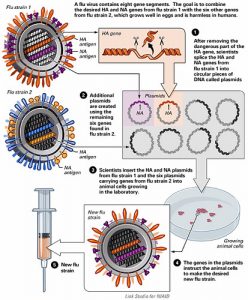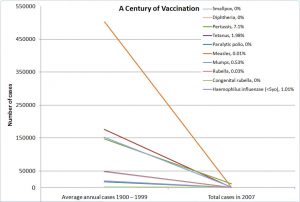22
Karamel Briant
Introduction
Keywords
Vaccines
Infectious diseases
Antibodies
Immunity
Learning Objectives
- After reading this chapter, the reader will be able to understand what a vaccine is and how they work.
- The reader will understand the history behind vaccines and how they were created.
- The reader will also be able to understand the controversy behind vaccines and how it may not be what it seems.
Every year the same commercials come on television about getting the flu vaccine, but have you ever wondered what is a vaccine, what do they do, and why do we need them? I have! Every year the doctor is prompting me to get vaccinated, but never tells me why the vaccination is helpful or even what a vaccination is. In this chapter, we will be talking all about vaccines, and we will be answering the questions you commonly wonder. In this chapter, we will discuss what a vaccine is, how it works, the history behind it, and the controversy surrounding them. Hopefully by the end of this chapter, you will have learned why vaccines are often the topic of conversation.
What is a Vaccine?
Key Takeaway
- This section will break down what a vaccine is and how the vaccine is able to work within your body.
A vaccine is a piece of a germ or whole germ that is taken from an infectious disease and injected into your body. The germ is taken from the disease that the vaccine is trying to fight. For example, the measles vaccine contains the measles virus, just like the flu vaccine contains the flu virus (CDC, 2012). However even though the germ has been taken from the virus it has been killed or weakened, so that it does not make your body sick.
How it works?
After the vaccine is injected into your body, the germ within it triggers the immune system to release antibodies. Antibodies are Y-shaped proteins produced by the plasma to neutralize bacteria and viruses. These antibodies fight the diseased germ within your body. Since the germ was injected into your body, the next time it re-enters your immune system it will be recognized, preventing you from becoming infected.

“Flu Vaccine: Reverse Genetics” by NIAID is licensed under CC BY 2.0
The History of Vaccinations
Key Takeaway
- This section will show how vaccines have changed throughout time and provide information on who helped bring the principles together.
Forms of vaccines have been seen to date nearly three thousand years ago, from the Chinese, Greeks, Indians, and many more (Gabain, Klaid, 2012, p. 2). However, earlier forms of vaccines are not what they are today. During the time of smallpox, the Chinese would inhale dried pus from the smallpox lesions, as a form of a vaccine, while the Turks would use shirts of the infected (Gabain, Klaid, 2012, p. 2). These ways may seem very unconventional, but despite that they proved to be effective and helped the body’s immune system to build up a tolerance for these viruses. Vaccines may not have come as far as they have if it weren’t for scientific giants that helped us to understand how vaccines worked and what they had to do with infectious diseases.
The Scientific Giants: There were many scientific giants that have helped progress vaccines to where they are today. But there were seven big ones that discovered the main concepts of how infectious diseases work and how our immune system works. Their names were Antony Van Leeuwenhoek, Lazzaro Spallanzani, Louis Pasteur, Robert Koch, Emil Von Behring, Ilya Mechnikov, and Paul Ehrlich.
Antony Van Leeuwenhoek (17th Century): Leeuwenhoek discovered bacteria, free living and microscopic protists, blood cells, sperm cells, and much more. His discovery helped fuel the study of microbiology which is how diseases are studied and also how viruses can be seen and understood.
Lazzaro Spallanzani (18th Century): Spallanzani discovered spontaneous generation in which he proposed that microbes can move through air and be killed by boiling them. This proposal later helped to pave the way for Louis Pasteur.
Louis Pasteur (19th Century): Pasteur discovered the principles of vaccinations, microbial fermentation, and pasteurization. His medical studies were a direct support for the germ theory. His discoveries have saved thousands of lives and made major breakthroughs in the world of vaccines.
Robert Koch (19th – Early 20th Century): Koch was one of the main founders of modern bacteriology and gave experimental support for the concept of infectious diseases. He also identified the specific causative agents of tuberculosis, cholera, and anthrax. These discoveries helped in the making of vaccines and helped develop the study of infectious diseases.
Ilya Mechnikov (19th – Early 20th Century): Mechnikov did pioneering research in immunology which helped to further educate the world on how cell immunity worked and how our body could become immune to viruses and bacteria. This helped the study of vaccines to be able prove that the immune system can build immunity towards viruses
Paul Ehrlich (19th – Early 20th Century): Ehrlich studied immunology, and found a cure for syphilis. He also discovered gram scanning bacteria which allows for staining tissue which makes it possible to distinguish between different types of blood cells.
As can be seen these seven giants helped further the field of study within vaccines when it came to immunology and bacteria. These contributions helped to make vaccines what they are today.
Controversies Around Vaccinations
Key Takeaways
- This section will discuss some of the major controversies that vaccines have had to face.
Over the years there have been many controversies surrounding vaccines but, one of the biggest was surrounding the MMR (measles, mumps and rubella)vaccine. Many people thought that this vaccine was causing autism with their children. To prove that there wasn’t a link to this vaccine and autism there was a study conducted by the British. This study consisted of the researcher looking at 240 children from the age of ten to twelve, of those two hundred and forty, 98 were diagnosed, 52 had special educational needs and the 90 left had no developmental disorder (Pediatrics for Parents, 2009, p. 9). After studying these three groups of children, the scientists concluded that there were not any differences in the measles antibodies or measles virus within the three groups. Meaning that the vaccine could not have been the reason for the children’s autism or special educational needs. Although this was the biggest controversy on vaccines, it is not the only one.
Another controversy surrounding vaccines is what they are made of and could it hurt you. The answer to this question is no, they can not hurt you. They are simply made up of things that are already in our body or we eat within our diet. The ingredients consist of adjuvants, stabilizers, and formaldehyde (CDC, 2019). Adjuvants help boost the body’s response to the vaccine and can also be found in aspirin. Stabilizers help to keep the vaccine effective after manufacturing, stabilizers are also found within Jell-O, meaning that they are not harmful. The last one, formaldehyde is to prevent bacteria contamination during the manufacturing process, although this sounds really dangerous we have formaldehyde in our body and there is more of it there then within the vaccines. Vaccines have had to overcome big controversies, but the biggest have been the MMR vaccine and what vaccines are made of. Vaccines have improved and grown due to these controversies and the results of them.
Chapter Summary

“vaccination-effects-20thC” by Monado is licensed under CC BY-SA 2.0
Review Questions
- When a vaccine is injected into your body, the germ triggers the immune system to release ________ a. B cells b. T cells c. Antibodies d. Neutralizers
- A flu virus contains how many gene segments? a. Six b. Eight c. Two d. Four
- Which culture inhaled dried pus from smallpox lesions? a. Turks b. Greeks c. Indians d. English e. Chinese
- Which of the seven giants discovered bacteria and made different forms of microscopes?a. Lazzaro Spallanzani b. Paul Ehrlich c. Louis Pasteur d. Antony Von Leeuwenhoek
Short Answer:
If a piece of a germ is injected into the body in the form of a vaccine, what happens after the germ reaches the immune system and how does this allow us to not get sick.
Answers
- C – Antibodies This answer can be found under “What is a vaccine?”.
- B – Eight This answer can be found in the picture within the first section.
- E – Chinese This was brought up during the “History of Vaccinations” section.
- D – Antony Von Leeuwenhoek This is found when each of the scientific giants were broken down.
References
Autism-MMR vaccine myth. (2009,January). Pediatrics for Parents, Retrieved from https://go-gale-com.libproxy.clemson.edu/ps/i.do?p=AONE&u=clemsonu_main&id=GALE%7CA194810738&v=2.1&it=r
Centers for Disease Control and Prevention. (2012, March 14). Vaccines: The Basics. Retrieved from https://www.cdc.gov/vaccines/vpd/vpd-vac-basics.html
Centers for Disease Control and Prevention. (2019, August 5). Making the Vaccine Decision: Addressing Common Concerns. Retrieved from https://www.cdc.gov/vaccines/parents/why-vaccinate/vaccine-decision.html
Ellis, C. (2014). Vaccines: Pros, Cons, and Controversies. In Vaccines (pp. 41-47). New York: Marshall Cavendish Benchmark.
Gabain, A. V., & Klade, C. (2012). Introduction. In Development of Novel Vaccines Skills, Knowledge and Translational Technologies (pp. 2-3). Vienna: Springer Vienna.
